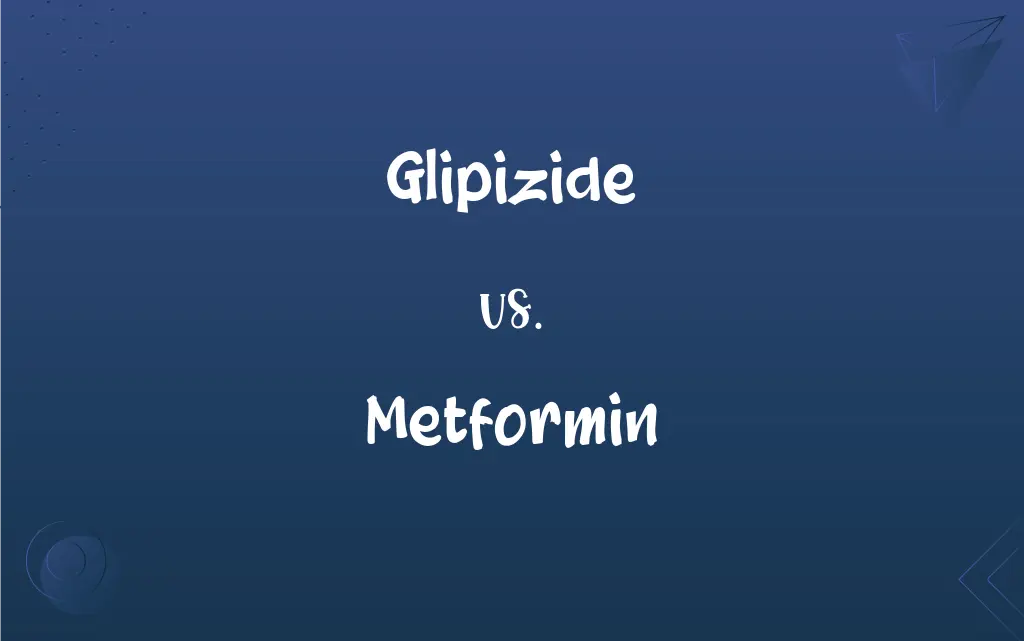Glipizide vs. Metformin: What's the Difference?
Edited by Aimie Carlson || By Harlon Moss || Updated on October 16, 2023
Glipizide stimulates the pancreas to produce insulin; metformin decreases liver glucose production and improves insulin sensitivity.

Key Differences
Glipizide is an oral diabetes medicine that helps control blood sugar levels by prompting the pancreas to produce insulin. This mechanism targets the body's own insulin-producing capabilities to release more insulin. Metformin, on the other hand, is a first-line medication for type 2 diabetes. It works by decreasing the amount of glucose produced by the liver and improving the sensitivity of muscle cells to insulin.
In terms of their classification, glipizide belongs to a class of drugs known as sulfonylureas. These drugs work on the pancreas, stimulating it to release more insulin. Metformin is classified under biguanides. Instead of focusing on insulin production like glipizide, metformin's primary action is on the liver, inhibiting its glucose production.
Both glipizide and metformin are taken orally, usually in the form of tablets. While glipizide is typically prescribed when diet and exercise alone do not sufficiently control blood sugar, metformin is often the first choice of medication for those diagnosed with type 2 diabetes. Its effects on the liver and insulin sensitivity make it a foundational treatment in diabetes care.
The side effects of these medications also vary. Glipizide may cause low blood sugar, weight gain, and skin reactions. Metformin can lead to stomach upset, metallic taste, and in rare cases, lactic acidosis. Regardless of the differences, both glipizide and metformin play critical roles in diabetes management.
Comparison Chart
Class of Drug
Sulfonylurea
Biguanide
ADVERTISEMENT
Main Mechanism
Stimulates pancreas to produce insulin
Decreases liver glucose production, improves insulin sensitivity
Typical Use
When diet/exercise isn't enough
First-line for type 2 diabetes
Common Side Effects
Low blood sugar, weight gain, skin reactions
Stomach upset, metallic taste
Dosage Form
Oral tablet
Oral tablet or solution
Glipizide and Metformin Definitions
Glipizide
An oral medication stimulating the pancreas to release more insulin.
With glipizide, my body produces more insulin naturally.
ADVERTISEMENT
Metformin
A biguanide drug that improves insulin sensitivity and reduces liver glucose production.
Metformin helps my body respond better to insulin while reducing sugar output from my liver.
Glipizide
A diabetes drug assisting in glucose control in the bloodstream.
After starting glipizide, my glucose readings became more consistent.
Metformin
A first-line oral medication used for treating type 2 diabetes.
Metformin has been a cornerstone in diabetes treatment for decades.
Glipizide
A remedy for when dietary changes and exercise do not sufficiently control diabetes.
Since diet alone wasn't working, my physician added glipizide to my regimen.
Metformin
A diabetic drug known for its effectiveness and low risk of causing low blood sugar.
My doctor prefers metformin due to its safety profile and efficacy.
Glipizide
A sulfonylurea drug used to treat type 2 diabetes.
The doctor prescribed glipizide to help control my blood sugar levels.
Metformin
A remedy often introduced at the onset of a type 2 diabetes diagnosis.
Shortly after my diagnosis, I began a regimen that included metformin.
Glipizide
A pharmaceutical agent targeting the body's insulin production capabilities.
Thanks to glipizide, my body can now make better use of the insulin it produces.
Metformin
A widely prescribed diabetes medication with multiple benefits for blood sugar control.
Along with lifestyle changes, metformin keeps my blood sugar levels in check.
Glipizide
A sulfonylurea drug, C21H27N5O4S, used to treat type 2 diabetes.
Metformin
An oral hypoglycemic drug, C4H11N5, usually used in its hydrochloride form, that decreases glucose production by the liver and increases peripheral glucose uptake, used to treat type 2 diabetes.
Glipizide
(pharmaceutical drug) A sulfonylurea antidiabetic drug C21H27N5O4S (trademark Glucotrol) that lowers blood glucose levels and is used in the control of hyperglycemia associated with type 2 diabetes.
Metformin
(pharmaceutical drug) A biguanide derivative, C4H11N5, used, now chiefly as the hydrochloride, as an oral hypoglycemic agent in the treatment of type 2 diabetes mellitus; 1,1-dimethylbiguanide.
Metformin
An antidiabetic drug (trade name Glucophage) prescribed to treat type II diabetes
FAQs
Can glipizide cause hypoglycemia?
Yes, a side effect of glipizide can be low blood sugar or hypoglycemia.
Is weight loss a common effect of metformin?
Yes, some patients on metformin experience weight loss as a side effect.
How does metformin function in the body?
Metformin reduces liver glucose production and enhances insulin sensitivity in cells.
Is glipizide an insulin?
No, glipizide stimulates the body to produce its own insulin.
What's the main difference between glipizide and metformin?
Glipizide stimulates insulin production, while metformin reduces liver glucose output and improves insulin sensitivity.
Is metformin safe for long-term use?
Generally, metformin is considered safe for long-term use, but regular monitoring is essential.
Is metformin suitable for prediabetes?
Yes, metformin is sometimes prescribed for prediabetes to prevent progression to type 2 diabetes.
What is glipizide primarily used for?
Glipizide is used to treat type 2 diabetes by stimulating insulin production.
What should I monitor while on glipizide?
Regular blood sugar checks are crucial, and be alert for signs of low blood sugar.
What class of drug is glipizide?
Glipizide belongs to the sulfonylurea class of drugs.
How often should I take metformin?
The frequency varies, but typically it's taken once or twice daily. Always follow your doctor's instructions.
Can metformin be used for conditions other than diabetes?
Yes, metformin is sometimes prescribed for conditions like polycystic ovary syndrome (PCOS) and other insulin-resistant states.
Can I take both glipizide and metformin together?
Yes, they can be prescribed together for better blood sugar control, but always follow your doctor's advice.
Are there any dietary restrictions when taking metformin?
It's essential to follow a balanced diet, and avoid excessive alcohol which can increase the risk of lactic acidosis.
What are the primary side effects of metformin?
Common side effects include stomach upset, diarrhea, and a metallic taste.
Is there a risk of dependency with glipizide?
No, glipizide doesn't lead to dependency, but it's essential to take it as prescribed.
What precautions should be taken with glipizide?
Monitor blood sugar regularly, be cautious with alcohol, and notify your doctor of any significant side effects.
Can glipizide cause weight gain?
Yes, weight gain can be a side effect of glipizide.
Why is metformin often the first choice for treating type 2 diabetes?
Due to its effectiveness, safety profile, and ability to improve insulin sensitivity, metformin is often the first choice.
How does glipizide differ from other sulfonylureas?
Glipizide primarily differs in its duration of action and specific side effect profile.
About Author
Written by
Harlon MossHarlon is a seasoned quality moderator and accomplished content writer for Difference Wiki. An alumnus of the prestigious University of California, he earned his degree in Computer Science. Leveraging his academic background, Harlon brings a meticulous and informed perspective to his work, ensuring content accuracy and excellence.
Edited by
Aimie CarlsonAimie Carlson, holding a master's degree in English literature, is a fervent English language enthusiast. She lends her writing talents to Difference Wiki, a prominent website that specializes in comparisons, offering readers insightful analyses that both captivate and inform.































































